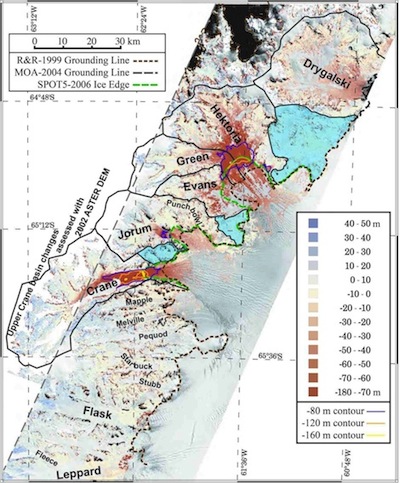New Study by UMBC-led Research Team Details Glacier Ice Loss Following Ice Shelf Collapse
Anthony Lane
University of Maryland, Baltimore County (UMBC)
410-455-5793
alane@umbc.edu
Patrick Lynch
NASA Goddard Space Flight Center, Greenbelt, Md.
757-897-2047
patrick.lynch@nasa.gov
Katherine Leitzell
National Snow and Ice Data Center, Boulder, Colo.
University of Colorado
303-492-1497
leitzell@nsidc.org
GREENBELT, Md. -- An international team of researchers has combined data from multiple sources to provide the clearest account yet of how much glacial ice surges into the sea following the collapse of Antarctic ice shelves.
The work by researchers at the University of Maryland, Baltimore County (UMBC), the Laboratoire d'Etudes en Géophysique et Océanographie Spatiales, Centre National de la Recherche Scientifique at the University of Toulouse, France, and the University of Colorado's National Snow and Ice Data Center, Boulder, Colo. details recent ice losses while promising to sharpen future predictions of further ice loss and sea level rise likely to result from ongoing changes along the Antarctic Peninsula.
"Not only do you get an initial loss of glacial ice when adjacent ice shelves collapse, but you get continued ice losses for many years — even decades — to come," says Christopher Shuman, a researcher at UMBC's Joint Center for Earth Systems Technology (JCET) at the NASA Goddard Space Flight Center, Greenbelt, Md. "This further demonstrates how important ice shelves are to Antarctic glaciers."
Shuman is lead author of the study “2001–2009 elevation and mass losses in the Larsen A and B embayments, Antarctic Peninsula“ published online today in the Journal of Glaciology.
An ice shelf is a thick floating tongue of ice, fed by a tributary glacier, extending into the sea off a land mass. Previous research showed that the recent collapse of several ice shelves in Antarctica led to acceleration of the glaciers that feed into them. Combining satellite data from NASA and the French space agency CNES, along with measurements collected during aircraft missions similar to ongoing NASA IceBridge flights, Shuman, Etienne Berthier of the University of Toulouse and Ted Scambos of the University of Colorado produced detailed ice loss maps from 2001 to 2009 for the main tributary glaciers of the Larsen A and B ice shelves, which collapsed in 1995 and 2002, respectively.
"The approach we took drew on the strengths of each data source to produce the most complete picture yet of how these glaciers are changing," Berthier said, noting that the study relied on easy access to remote sensing information provided by NASA and CNES. The team used data from NASA sources including the MODerate Imaging Spectroradiometer (MODIS) instruments and the Ice, Cloud and land Elevation Satellite (ICESat).
The analysis reveals rapid elevation decreases of more than 500 feet for some glaciers, and it puts the total ice loss from 2001 to 2006 squarely between the widely varying and less certain estimates produced using an approach that relies on assumptions about a glacier's mass budget.
The authors’ analysis shows ice loss in the study area of at least 11.2 gigatons per year from 2001 to 2006. Their ongoing work shows ice loss from 2006 to 2010 was almost as large, averaging 10.2 gigatons per year.
“This study shows where the tracking of sea level rise is heading in terms of the level of detail possible and the instrumentation that can be brought to bear,” Scambos said. “We’re showing that glacier changes can start fast, with a single climate or ocean ‘bang’, but they have a long persistence.”
An animation showing ice edge changes for the Larsen B ice shelf and its adjacent tributary glaciers is available online, along with a larger version of the map below showing elevation changes of tributary glaciers.
A companion paper — “The triggering of sub glacial lake drainage during rapid glacier drawdown: Crane Glacier, Antarctic Peninsula” — by the same three authors, led by Scambos, is also available online in the Annals of Glaciology in the issue “Earth's Disappearing Ice: Drivers, Responses and Impacts.”

Posted: July 25, 2011, 12:00 PM